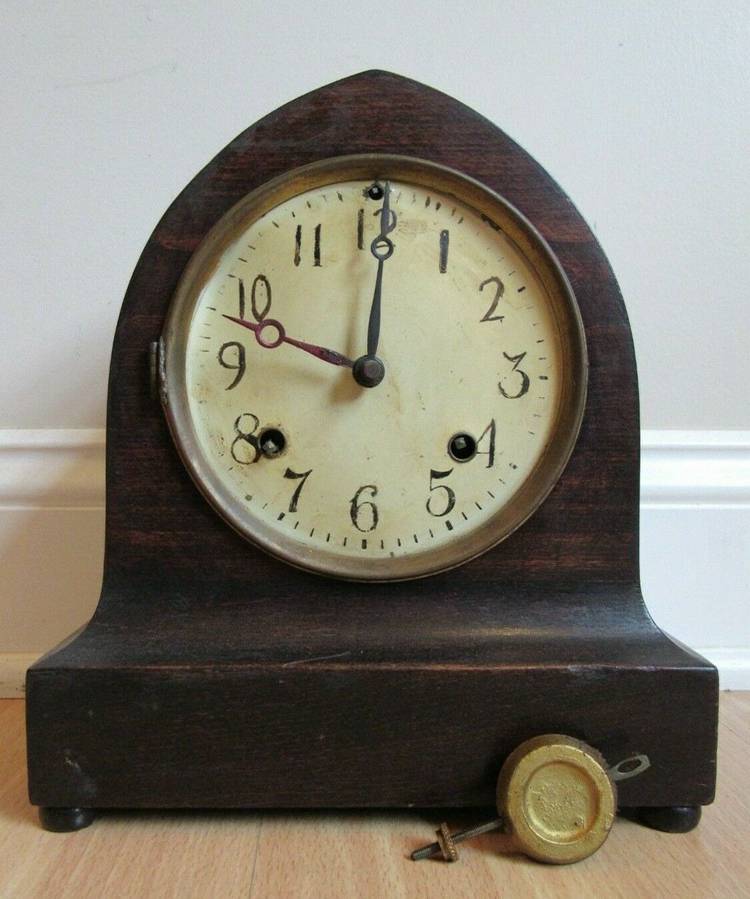
Do you have an ardent interest in antique clocks? If so, you might be interested in finding out more about the New Haven Clock Company and the exquisite clocks they produced. One of the major clock manufacturers in the 1800s was the New Haven Clock Company. Collectors are still interested in the stunning clocks that were manufactured by the company.
The history of the company, some of the most well-known clocks, where to buy them, and how to identify whether you own an original one will all be covered in this article.
Table of Contents
New Haven Clock Company’s History
Let’s start by taking a quick look at the history of one of the most renowned clock companies at the time.
In the New Haven, Connecticut, region, Hiram Camp, and a few other clockmakers established the New Haven Clock Company in 1850. Camp’s uncle Chauncy Jerome controlled the nearby Jerome Manufacturing Company, and the company’s objective was to bulk manufacture brass clock movements for him.
A few years later, the New Haven Clock Company acquired Jerome’s business and carried on the tradition of producing excellent timepieces. In fact, by the 1880s, New Haven’s clocks and non-jeweled pocket watches were well-known for their superior craftsmanship.
Additionally, they offered clocks and pocket timepieces produced by many multiple companies, such as:
- Boston’s E. Howard Company
- Company F. Kroeber of New York
- Ingraham Clocks was later known as E. Ingraham of Bristol, Connecticut
The New Haven company had a successful and prosperous period in the 19th century. Then they persisted and throughout the years produced a ton of magnificent pieces, even branching out into wristwatches. Surprisingly, they made it through the Great Depression and changed their line of work to help with the war effort in World War II.
However, they had a sharp decline in business in the 1950s, and in 1960 they were forced to file for bankruptcy and sell off a portion of their company in a private deal, effectively closing its doors for forever.
Identification of Antique New Haven Clock
Now that we know more about the history of the New Haven Clock Company, let’s look at how to identify vintage New Haven clocks.
Don’t worry if you’re unsure if the clock you have is a New Haven. We can guide you through the process.
Company’s Label
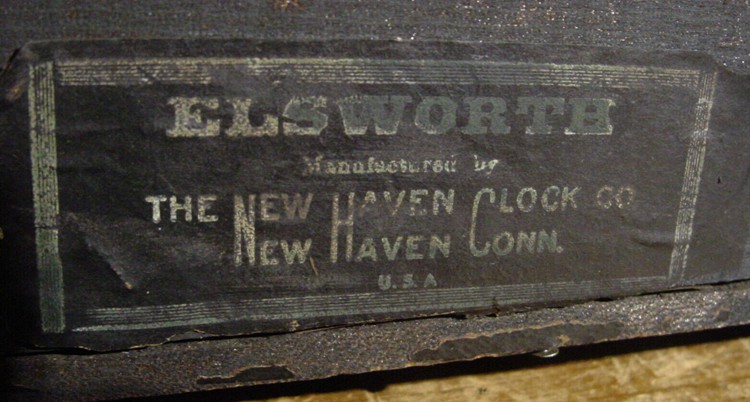
By far, glancing at the label is the most effective approach to determine if you have a vintage New Haven clock. The corporate name was frequently written in large letters over the dial by New Haven. Also, within the case or on the back of the clock is a paper label.
They initially put “Jerome & Co.” on their label because it was a far more recognizable name. But eventually they were so well recognized that they started labeling their products with “New Haven Clock Co.” Therefore, learning the name of the clock could help you estimate when it was manufactured.
Manufacturer’s Name
Clockmakers used to imprint their names to the movements they created. Knowing the manufacturers of New Haven clocks may help you determine whether your clock is an original from the New Haven Clock Company or a replica.
An Expert and Reputable Appraisal
While the maker’s name and the company’s label are occasionally reliable signs, they can also provide you with information that is fake or fraudulent.
For instance, you might not always be able to tell if the clock’s movement is the original one or one that was added years later during repair. Additionally, a clock’s paper label might have been misplaced, broken, or removed from one clock and pasted on another (identical) clock to sell it for more money.
Your clock’s authenticity or if it is a replica can be determined by a trustworthy and competent vendor. However, a cunning dealer can try to deceive you, so it’s crucial to pick one who is dependable, trustworthy, and knowledgeable about antique clocks.
You may always take your clock to an appraisal or antiques vendor for assistance if you’re still unsure if it’s a New Haven clock, or you may execute a Web search to learn more about a reputable antique clock identification website.
Determining the Value of New Haven Clock
The price of a New Haven clock can differ significantly based on its condition, age, kind, and style. For instance, a tall case clock or an elegant grandfather clock from the 1880s could be valued several thousand dollars, whereas a basic wall clock from the 1950s might only be worth a few hundred dollars (or less).
Simply put, it depends! At this point, checking online auction portals and speaking with an experienced and reputable dealer are both wise decisions. The more routes you take, the more probable it is that you will receive an appropriate appraisal of the clock you are in possession of.
Famous New Haven Clocks
The trademark “Jerome & Co.” may be seen on New Haven Clocks because of the connection to the Jerome Company. Jerome was significantly more well-known than New Haven on a global scale, thus the business continued to utilize this trademark until 1904. Additionally, the business went by the name New Haven Clock Co. It is frequently printed on the clock’s face, adhered to the casing, or located on the back. An antique clock is typically easy to identify.
Experts and clock collectors believe that this successful company produced more than 300 different designs of clocks. The following are a few of the clocks produced by the New Haven Company:
Calendar Clock
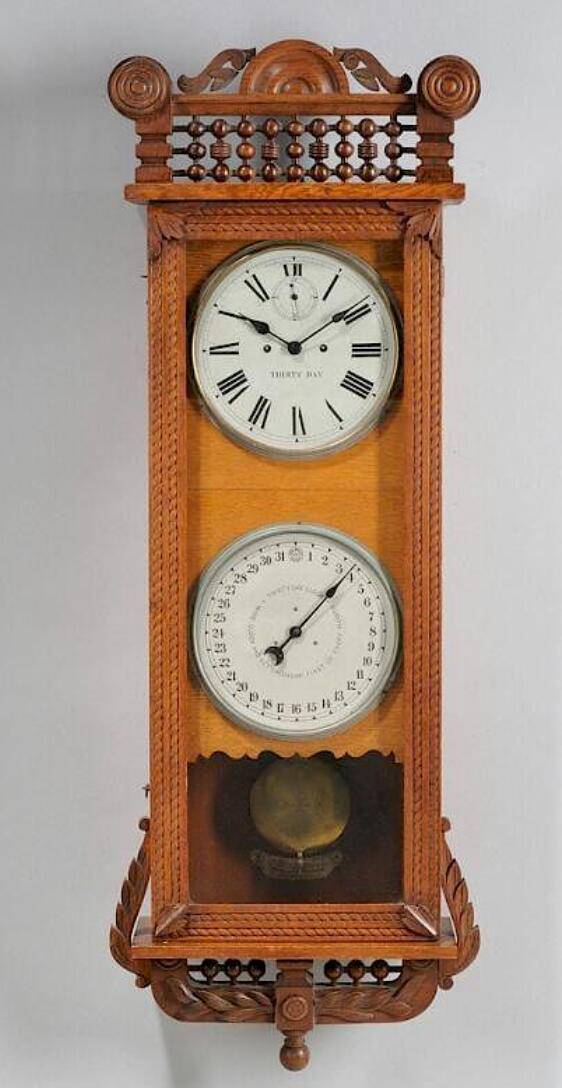
The calendar clock was a distinctive take on clocks and a style that was infrequently produced by other companies. In addition to displaying time, they frequently had a second dial on the front that displayed the day of the week, date, and the month as well.
Banjo Clock
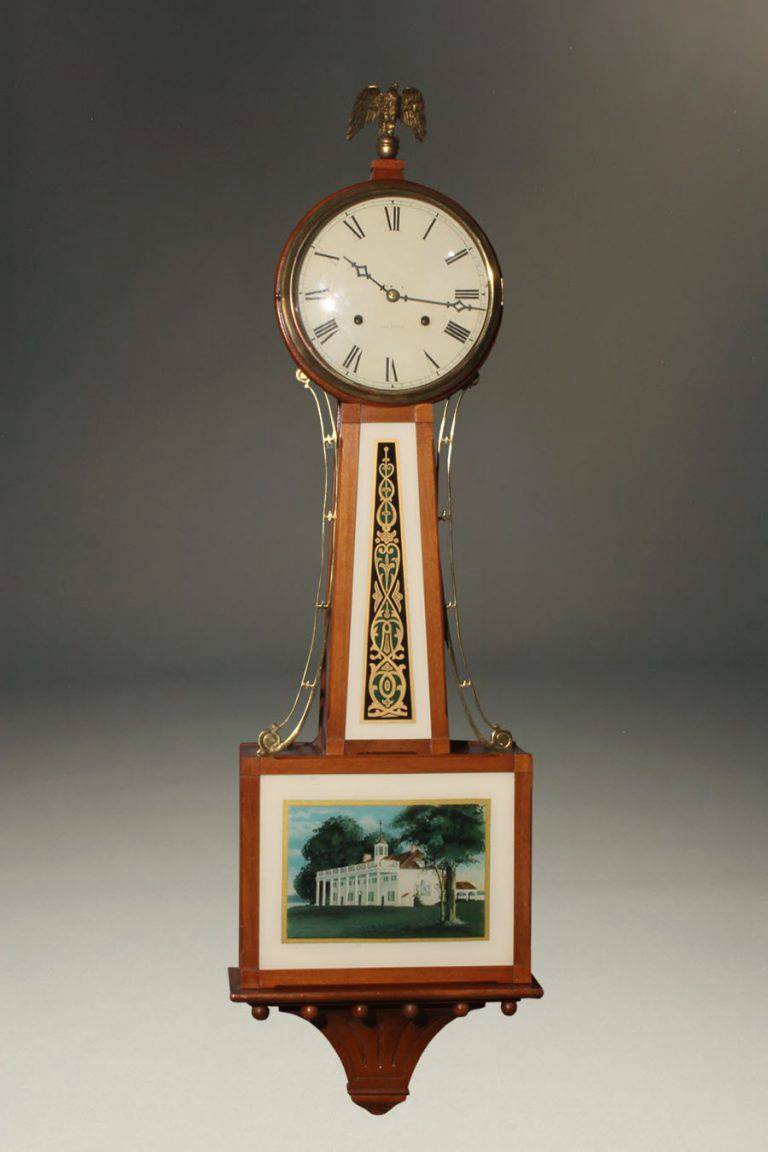
The first banjo clock was made in 1802, making them some of the most remarkable wall clocks. These lovely clocks were rapidly included in New Haven’s line of goods. They featured a long, narrow face and frequently had an elegant wood box and glass.
Flying Pendulum Clock
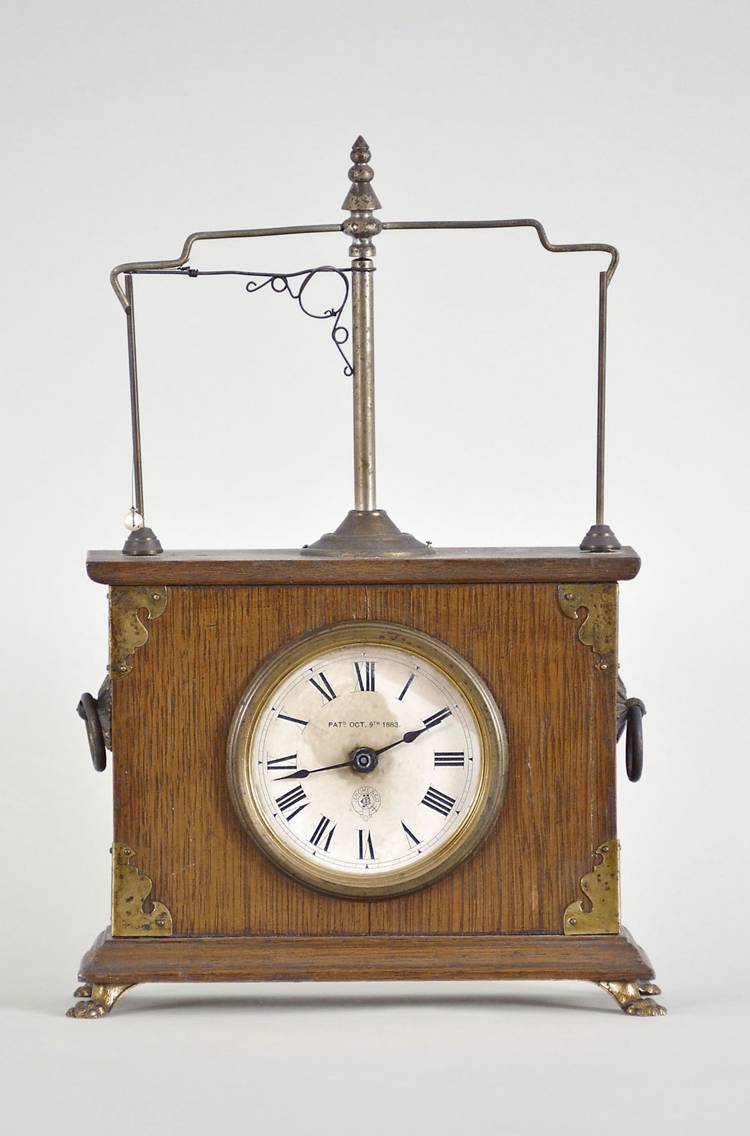
The Ignatz, or flying pendulum clock was originally made available in 1884, and it quickly became one of New Haven’s most famous timepieces. Instead of a pendulum that just swings back and forth like a conventional escapement, these clocks include a long ball-like pendulum that “flies” through the air like a tetherball.
Clock enthusiasts are quite interested in these since they were only made for roughly a year.
Grandfather Clock
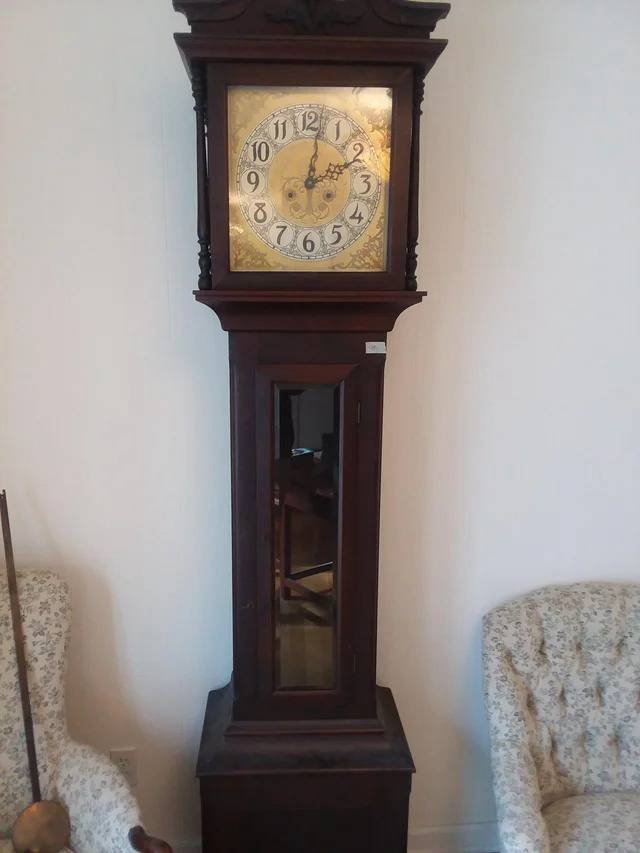
Clocks from New Haven company, often known as tall case or grandfather clocks, are tall and have a formal appearance. They were intended to serve as heirlooms that could be passed down through the generations.
In addition to making non-jeweled wristwatches and pocket watches, they made a wide variety of clocks. They also produced the following types of clocks in addition to the ones already mentioned:
- Statue Clocks
- Display Clocks
- Chinese Clocks
- Regulators
- Mantle Clocks
Guidance on Antique Mantle Clocks
The mantel clock is one of the most well-liked clock designs produced by the New Haven Clock Company. The great diversity of vintage and antique mantle clock models might be bewildering for a novice collector. To become familiar with clock maker names and appealing Mantle clock styles, browse through some auction sites and online antique sellers.
Think about the kind of clock that will go best with the design of your house.
If you’re fortunate enough to own one of these exquisite antique clocks, you’ll want to keep it in good condition so it can continue to serve you well. The place should be carefully chosen. Hence, these guidelines must be followed to own you own Vintage New Haven Clock.
- The hands must always be turned clockwise. The only exception is if the chime needs to be set. Until the clock chimes properly, slowly turn the hour hand counterclockwise from 11 to 9. Use no pressure.
- When adjusting the time, never push the hands.
- Select a level surface. With a level, you should verify the correctness of this. Even a slight imbalance in the clock’s foundation will prevent the pendulum from swinging freely.
- Gently wipe the clock down.
- Before transporting the clock, remove the pendulum.
- To clean the glass, apply vinegar or a mild glass cleaner. Spray a little of it on a soft piece of flannel instead than directly onto the glass and gently brush it over the surface.
Where to Find Antique New Haven Clocks?
Since there were so many of these clocks produced, collectors can find a variety in practically every price range. Keep an eye out for antique shops and auctions in your area. Since most people are aware of the worth of these specialized timepieces, you won’t frequently find one at a garage sale or thrift store.
Throughout this article, you learned a lot about New Haven clocks. Now that you’ve seen them, you might be tempted to start a collection or at the very least buy one for your fireplace mantle. They are in fact beautiful enough to be bought and used.
If so, you might be curious as to where you can locate them. Check out these spots:
- Antiquarian Shops
Another choice is to go to the neighborhood antique shops. These shops occasionally have New Haven clocks for sale. However, pricing might vary widely, so you should shop around to find a competent, reliable vendor. Before making a purchase, it’s also crucial to comparison shop and check prices, if you can.
- Online Marketplaces and Auctions
Online auction sites like eBay, Tias, and Rubby Lane as well as websites where antiques are sold, like Etsy, frequently have New Haven clocks for sale. These websites are fantastic places to start your search but do your investigation before placing a bid or making a purchase!
- Clock Appraisals
New Haven clocks are the focus of a sizable number of clock sellers, both offline and online. They frequently have a large range of New Haven clocks in stock, and they might also be able to answer any queries you have. There are numerous alternatives for purchasing and collecting New Haven clocks.
Considerations Before Buying
Prior to purchasing a vintage or antique mantel clock, you should also keep in mind these considerations:
- Condition – A working clock will be worth more if the parts are completely original, but only in that case. Glass chips and finish scratches should be looked for.
- Transportation– If a clock is not correctly packaged for shipping, the fragile parts within could easily be harmed. To ensure that your clocks arrive safely, ask internet merchants how they package them.
- Authentication– Check for the Maker’s Mark to help confirm the authenticity of a mantel clock.
Conclusion
The price of elegant, collectible Antique New Haven clocks can range from a few hundred to several thousand dollars. They come in a variety of designs, such as calendar clocks, wall clocks, grandfather clocks, and the history of their manufacturer is incredibly fascinating.
There are numerous websites to check for Vintage New Haven clocks if you’re interested in collecting them or even just owning one, but make sure to do your investigation so you know you’re getting a good deal before making any purchase decision!
An antique New Haven clock will give your home a genuine vintage vibe, regardless of where you get it or what type you choose. Ask the vendor for instructions on how to set up and maintain the clock once it is in your home as well as how to make various modifications. These well-known clocks have been telling time for more than a century, and with proper care, they may easily last another century.
FAQS
How do you recognize a New Haven clock?
It is frequently printed, adhered, or attached to the back of the clock or its face. An antique clock is usually easy to recognize. According to experts and clock enthusiasts, this successful company produced approximately 300 different designs of clocks.
Is the New Haven Clock Company still in operation?
It was constructed between 1866 and 1937 and comprises of ten interconnected brick structures that served as the foundation for a significant clock-making enterprise that was located here until 1956. In 2017, the house was added to the National Register of Historic Places.
How can the age of a clock be determined?
The other factors listed below are helpful when attempting to identify or date an antique clock:
The clock styles
A gong, bell, or other type of striking device
A serial number
Paper, ceramic, wood, or tin are some examples of dial material
The stenciling, handwriting, fasteners, and glass type of the clock.
How can a mantel clock be dated?
Your clock was probably created after 1905, the first-year plywood was utilized for mantel clocks, if it is made of plywood. It is likely to date to the 1930s or 1940s, when Bakelite reached the height of its popularity if it is manufactured of the molded plastic renowned as Bakelite.
What distinguishes a grandfather clock from a grandmother clock?
What distinguishes a grandfather clock from a grandmother clock? Grandpa clocks and grandmother clocks are both long case pendulum clocks, although grandfather clocks are often taller than grandmother clocks, standing between 6 and 7 feet, compared to grandmother clocks’ typical height of 5 to 6 feet.
How may a vintage clock be valued?
Instead, you should request an appraisal from a disinterested expert who is unconnected to the object you’ve brought them. Look for an appraiser who is a member of a professional appraisal society to ensure you’re using a qualified, certified appraiser.
How can a clock movement be identified?
Remove the clock’s back to expose the movement to identify the movement manufacturer. Look for numbers or symbols on the movement’s back. Some clocks have difficult-to-read numbers that necessitate some sleuthing with a flashlight.
How old must a clock be to be considered vintage?
A vintage clock is at least one hundred years old. Your clock is deemed vintage if it is less than 100 years old. The website and clock community at various websites have more information concerning the age and possible origins of your mantel clock.
Why are there certain numbers on a clock movement?
Even though the manufacturer’s name might not be printed on the movement, the numbers will reveal it. The movement number typically provides information on the manner the clock chimes, where the chime hammers are located, whether it is spring- or weight-driven, and much more.
Exactly how is the clock movement reconfigured?
To begin with, the clock movement is taken apart entirely and cleaned. All the worn pivot holes are corrected next, and after that, they are all drilled out to the right size for the bushing they will be receiving. After that, the bushings are forced into the holes and, if necessary, the pivots’ clearance is increased with a bushing reamer. After being cleaned, lubricated, and replaced, the mainsprings. After that, the movement is oiled, put back together, and carefully examined.
How can I change the mantel clock’s chime?
The minute hand, which is friction-fit on most mantel clocks, is easily removable. The tube must be pushed to become loose. Reinstall the minute hand at the right time after it has been removed. The minute hand can then be turned there to reset the time.
How can I get my mantel clock’s time and chimes to sync?
Set the time by advancing the large hand and stopping it at 11 o’clock. Before continuing, wait for the quiet sound of a spring relaxing. Place the huge hand at the hour of twelve. Wait a moment and listen for the number of times the small hand on the clock indicates to strike.
How the Clock Movement appears to be wearing?
The two brass plates, two mainsprings, and twelve gears that are sandwiched between them make up the New Haven Clock Movement. Two pivots, one at either end of each gear shaft, ride in a hole in each of the plates. The mainspring’s pressure causes the first gear to rotate in one way as the movement moves along, and that gear then causes the next gear to rotate in the opposite direction. The pivot holes in the plates will wear in the direction that the pressure presses the gear to drive the clock. More power is required to keep the movement moving as the holes deteriorate because the gears drag more as they fall out of alignment.
What is the manufacturer’s name of my clock?
First, look at the dial. It’s likely that the manufacturer’s name or trademark will appear on the dial, either in plain or in the form of a distinguishing acronym or logo. Your task was simple if a name or trademark exists. The manufacturer’s name was a lucky find for you.
How do I determine the age of my antique clock?
It can occasionally be possible to date an antique clock using a signature on the dial or movement. If you can locate the name of the clock manufacturer and the date of operation in one of the many manuals available to watch and clockmakers. A signature, however, could not always be the clockmakers.
Our Takeaway!
Clocks from New Haven are a wonderful addition to any collection, and their elegance will brighten any room. You won’t be sorry if you get one of these!
We trust that this article New Haven Clock Company has improved your knowledge of the background, significance, and process involved in identifying and dating your clock. Feel free to leave a comment below if you have any more queries.
Thank You!





![Where To Sell Antique Furniture In 2022 [Ultimate Guide]](https://www.jacquelinestallone.com/wp-content/uploads/2022/09/Etsy-Your-Place-To-Buy-And-Sell-All-Things-Handmade-600x450.jpg)


